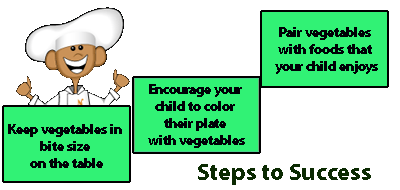
Many children can be picky eaters, and it’s no surprise that the first things to get picked off dinner plates are green vegetables. Vegetables are important for people of all ages, but especially for children, as they are growing and developing and need proper nutrition to do so. Each vegetable differs in its nutrition facts, but most green vegetables are good sources of many vitamins and minerals. Some examples include fiber, which is important for a healthy digestive tract, B vitamins for a healthy metabolism, iron for healthy red blood cells, vitamin C for immune strength, vitamin A for healthy eyes, and vitamin K and calcium for bone strength.
Since most kids care about taste over nutrition, telling them the health benefits isn’t a likely way to get your child to eat brussel sprouts. Instead, try the ideas below!
1) Mix into soups and sauces. Add extra frozen vegetables such as peas and green beans to chicken noodle soup, or chop up spinach and blend it into spaghetti sauce! You can also make a homemade vegetable soup, such as corn chowder, carrot ginger, and potato leek.
2) Serve with a dip. Spread peanut butter and raisins onto celery for ants on a log, and serve broccoli and baby carrots with low-fat ranch dip or hummus for an afterschool snack.
3) Blend into a smoothie. If your child enjoys smoothies, throw a handful of spinach into the next blend! Spinach is virtually tasteless, but can turn the smoothie mint green. Add a dark fruit such as blueberries or strawberries for a nice color that masks the green from the spinach.
4) Make it mashed. Many kids like mashed potatoes, but potatoes aren’t the only veggie that can be mashed! Try mashed cauliflower, sweet potato, butternut squash, carrots, or beets to add a pop of purple.
5) Drink it as juice. Juicing requires a lot of fruits and vegetables, so it’s great way to get multiple servings of vitamin and minerals in one drink. Companies such as V8 sell pre-bottled vegetable juices that taste like fruit, but if you have a juicer you can make your own. Many stores also sell oversized bags of juicing greens for your convenience.
6) Serve in sandwiches. Lettuce and tomato are easy to sneak onto sandwiches for extra veggies, but you could also try spinach, kale, arugula, red onion, bell peppers, or cucumber. This trick can be used with burgers and tacos or quesadillas as well!
7) Mix into casseroles. Casseroles such as tuna noodle and macaroni and cheese are easy dishes to add more vegetables into. Peas, carrots, broccoli, corn, and spinach pair well with these kid-friendly dinner dishes.
8) Top it on pizza. Like sandwiches, veggies are easy to sneak onto pizza. Broccoli, tomatoes, onions, bell peppers, and spinach are common pizza veggie toppings. Make the pizza together as a family and let everyone choose their veggie toppings. Bonus: For the sauce, blend in spinach for even more nutrition!
9) Bake them as fries. French fries are a child favorite, but like mashed potatoes, white potatoes aren’t the only vegetable that can be cooked as a fry. Try sweet potatoes, zucchini, cauliflower, or carrots. Cover in light breading such as panko crumbs or quinoa first, then bake.
10) Sneak into desserts. Many desserts can be made with vegetables without sacrificing taste or texture. Zucchini and carrots are commonly baked into muffins, and brownies can be made using sweet potatoes.
Try to make eating vegetables fun but letting your children help prepare them for dinner, and showing them different ways to incorporate the vegetables into meals and snacks.

0 Comments